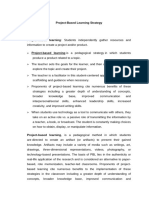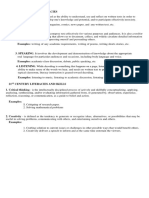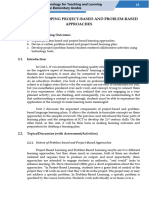Projects and Project-Based Learning - What's The Difference
Uploaded by
Kalesware MuniandyProjects and Project-Based Learning - What's The Difference
Uploaded by
Kalesware MuniandyProjects and Project-Based Learning:
What’s the Difference?
December 5, 2019
Dr. Lori McDonald
Elementary School Teacher; Ed.D. in School Leadership/Administration
Home Educators Blog
SHARE:
Click to share on Facebook (Opens in new window)
Click to share on LinkedIn (Opens in new window)
Click to share on Twitter (Opens in new window)
Click to print (Opens in new window)
Building a model of the solar system, writing and presenting a book
report, creating a model habitat, completing a science fair project,
making a collage – these are all examples of school projects. For
teachers, projects provide the opportunity for some creative
expressions of learning. It also gives parents the opportunity to be
involved with the learning, as projects are, often times, completed at
home. Is this the method we’ve heard about called project-based
learning? Not quite. These are projects. Project-based learning is
very different.
What is Project-Based Learning?
Project-based learning (PBL) is an approach to teaching through
which students are fully immersed in the learning. It is all
encompassing. PBL is defined as “an instructional methodology
that encourages students to learn and apply knowledge and
skills through an engaging experience.” PBL begins with a
driving question or problem. Also, PBL is a long-term learning
activity that can last anywhere from one week to a semester. It can
focus on any subject area but is always interdisciplinary. Effective
PBL may use math, science, social studies, language arts, and
more to solve real problems in a way that more accurately
simulates what actual problem-solving is like in the workforce.
There are some characteristics that are consistently present in PBL.
Characteristics of PBL:
1. Driving question based on a relevant, real-world problem
2. Engaging/sparks students interest
3. In-depth inquiry and discovery
4. Integration of technology
5. Led by students/student ownership
6. Reflection and revision as needed
7. Cross-curricular
A Few Examples of PBL:
1. Fighting Hunger – Students raise a garden, evaluating the
most productive methods for growth. Students use what they
produce to provide food for homeless shelters. Students could
also look for ways to promote others to fight hunger in different
ways in the community.
2. Coding/building a robot – Students work together to code/build
a robot to perform certain tasks. This would include a great
deal of test and revision.
3. Design an app – Students design an app for a particular
audience and purpose. This would involve technology,
problem-solving, marketing, and budgeting, just to name a
few.
4. Environmental Impact – Students research the environmental
impact of some industry or businesses in the area and come
up with ways to prevent or stop the negative impacts. This
may involve reaching out to the public or writing a
congressman to promote a positive change.
How Project-Based Learning Differs from Projects
So, even though many hear and misunderstand the term project-
based learning, it is important to note that simply assigning projects
is as different from PBL as night is from day. To further illustrate the
characteristics of PBL, imagine this scenario with me. It’s time for a
holiday dinner with the whole family, including aunts, uncles, and
cousins. Each relative sits in a different room in the house, all
alone. To socialize with each family member, you have to go into
each separate room, sit down, and talk to that relative. Sound fun?
Maybe. Maybe not. Sound efficient? Certainly not. This is an
example of how school projects work. It’s not a bad thing. It just
leaves subjects and content very isolated and compartmentalized.
Now imagine all the family members crammed into one room in the
house, say the living room. The room is filled with conversation and
laughter. This conversation sparks another conversation. Everyone
gets to spend time with everyone. This is project-based learning.
Cross-curricular skills are married in a long-term problem-solving
activity. Students brainstorm and bounce ideas off one another. It is
very interactive, engaging, and cooperative. Students use what
they have learned in multiple disciplines to solve problems within
the project.
Significant differences in PBL and projects:
Real world situations – Unlike projects, PBL is based on real-world
situations. Students collaborate to solve a realistic, relevant
problem.
Student ownership – Students lead and work through the problems
that arise in PBL together. The teacher is there to facilitate.
Rigidity vs. fluidity – Projects have rigid requirements. Teachers
assign projects and dictate how they are to be completed. Often,
projects have accompanying rubrics with very specific criteria that
must be met in order to get the best grade. PBL is much more fluid
as the project evolves and improves as theories are tested.
Level of Teacher Involvement in Projects vs. PBL
The teacher is far more involved as the imparter of knowledge in
a classroom that utilizes projects as opposed to a PBL classroom.
Projects simply provide a different way for students to express
learning. Projects can be a great way to allow students of different
learning styles to express learning. The teacher delivers information
to students on a given subject and then outlines, very specifically,
how students are to demonstrate that learning through a project. Of
course, some teachers will allow more student choice than others. It
all depends on the teacher’s individual style.
Projects are about an outcome. It’s a type of summative
assessment. PBL is a totally different way of looking at learning.
It’s as much about the process as it is the product. Students grow
and learn in a much more realistic environment and become better
prepared for their futures in the process.
#PBL, #projectbasedlearning
You might also like
- Project-Based Learning Applied to the Language ClassroomFrom EverandProject-Based Learning Applied to the Language ClassroomNo ratings yet
- Revisiting of PB Learning Plan: Integration of The Use of Digital and Non Digital Resources and Assesment Tools in The LP ProcedureNo ratings yetRevisiting of PB Learning Plan: Integration of The Use of Digital and Non Digital Resources and Assesment Tools in The LP Procedure12 pages
- Tara Ikner - Project-Based Learning - AssignmentNo ratings yetTara Ikner - Project-Based Learning - Assignment12 pages
- Problem Based Learning and Project Based LearningNo ratings yetProblem Based Learning and Project Based Learning19 pages
- Authentic Project-Based Learning With Digital Portfolios: by Jill Ackers-Clayton and Dayna LaurNo ratings yetAuthentic Project-Based Learning With Digital Portfolios: by Jill Ackers-Clayton and Dayna Laur41 pages
- A Beginner's Mind: Stephen Temple, EditorNo ratings yetA Beginner's Mind: Stephen Temple, Editor12 pages
- Problem Based Learning and Thinking Based Learning100% (1)Problem Based Learning and Thinking Based Learning20 pages
- 6 Strategies For Differentiated Instruction in PBL - EdutopiaNo ratings yet6 Strategies For Differentiated Instruction in PBL - Edutopia5 pages
- Project Based Learning in Bismarck Public SchoolsNo ratings yetProject Based Learning in Bismarck Public Schools8 pages
- Chapter 3. The Teacher and the CommunityNo ratings yetChapter 3. The Teacher and the Community15 pages
- SED 3205 - Fundamental of 21st Century LiteraciesNo ratings yetSED 3205 - Fundamental of 21st Century Literacies11 pages
- Pedagogy Symbol Explantions For StudentsNo ratings yetPedagogy Symbol Explantions For Students7 pages
- EDUC5272 Week 3 Written Assignment Unit 3No ratings yetEDUC5272 Week 3 Written Assignment Unit 38 pages
- 6 Strategies For Teaching With Bloom's TaxonomyNo ratings yet6 Strategies For Teaching With Bloom's Taxonomy4 pages
- Session Topic: Project Based Learning Time: 1:40 To 2:20 Scribe: BrittanyNo ratings yetSession Topic: Project Based Learning Time: 1:40 To 2:20 Scribe: Brittany2 pages
- Language Orientation Virtual EnvironmentNo ratings yetLanguage Orientation Virtual Environment16 pages
- Topic 2 ML-2-SHARE-Reflective-ConversationNo ratings yetTopic 2 ML-2-SHARE-Reflective-Conversation5 pages
- Mr. Balda'S Newsletter: What Is Project-Based Learning?No ratings yetMr. Balda'S Newsletter: What Is Project-Based Learning?1 page
- Reflection On Professional Development Plan100% (2)Reflection On Professional Development Plan2 pages
- Acid and Alkali: 6.1 Properties of Acids and AlkalisNo ratings yetAcid and Alkali: 6.1 Properties of Acids and Alkalis2 pages
- Overview of Curriculum Change: A Brief Discussion: Nilay Mondal Dr. Arjun Chandra DasNo ratings yetOverview of Curriculum Change: A Brief Discussion: Nilay Mondal Dr. Arjun Chandra Das6 pages
- Project-Based Learning Applied to the Language ClassroomFrom EverandProject-Based Learning Applied to the Language Classroom
- Revisiting of PB Learning Plan: Integration of The Use of Digital and Non Digital Resources and Assesment Tools in The LP ProcedureRevisiting of PB Learning Plan: Integration of The Use of Digital and Non Digital Resources and Assesment Tools in The LP Procedure
- Authentic Project-Based Learning With Digital Portfolios: by Jill Ackers-Clayton and Dayna LaurAuthentic Project-Based Learning With Digital Portfolios: by Jill Ackers-Clayton and Dayna Laur
- Problem Based Learning and Thinking Based LearningProblem Based Learning and Thinking Based Learning
- 6 Strategies For Differentiated Instruction in PBL - Edutopia6 Strategies For Differentiated Instruction in PBL - Edutopia
- Project Based Learning for Out of School TimeFrom EverandProject Based Learning for Out of School Time
- Session Topic: Project Based Learning Time: 1:40 To 2:20 Scribe: BrittanySession Topic: Project Based Learning Time: 1:40 To 2:20 Scribe: Brittany
- Mr. Balda'S Newsletter: What Is Project-Based Learning?Mr. Balda'S Newsletter: What Is Project-Based Learning?
- Acid and Alkali: 6.1 Properties of Acids and AlkalisAcid and Alkali: 6.1 Properties of Acids and Alkalis
- Overview of Curriculum Change: A Brief Discussion: Nilay Mondal Dr. Arjun Chandra DasOverview of Curriculum Change: A Brief Discussion: Nilay Mondal Dr. Arjun Chandra Das




































































